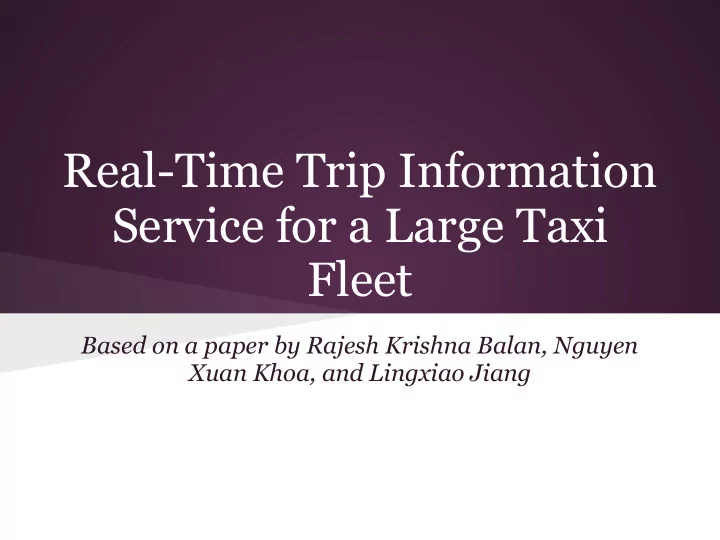

Real-Time Trip Information Service for a Large Taxi Fleet Based on a paper by Rajesh Krishna Balan, Nguyen Xuan Khoa, and Lingxiao Jiang
Goal ● A system that uses historical taxi trip data to allow passengers to query the expected time and cost of a taxi trip that they plan to take. ● One taxi company in Singapore
Challenges ● Amount of data (tens of millions of records each month) ● Ability to answer queries in real time ● Accounting for various time-related factors (peak hours, highly variable taxi fare in Singapore). ● How much historical data to use ● How to filter out noise in data
Singapore taxi system ● 710 km 2 of area (37% larger than Warsaw) ● Densely populated - 5 million people (3 times more than in Warsaw) ● Taxis widely available and low priced ● ~25k taxicabs ● Ad-hoc pricing is not allowed ● Complicated charges ● Most pickups are street pickups ● Taxis are used for all activities
Data ● GPS in every taxi ● Start point, end point, distance, fare ● Intermediate points discarded ● 15k taxicabs, 35k taxi drivers ● 21 months ● 250 million trip records ● 3.6% trip records were anomalous (location errors, semantic errors)
Data 10k random points from one day's data (0.3% one day's data)
Data ● Taxis were occupied 30% of the time ● Many trips with the same start and end place
Service requirements ● Accuracy (2 S$, 5 minutes) ● Real-time capability ● Low computational requirements (2 64G servers) ● Easy to deploy
Failed solution: Google Maps ● Network latencies and rate limits ● Problems with accuracy (about 40% errors) ● Local taxi trip prediction system (gothere.sg) had the same problems
Solution: trip history ● Basic features: start location, end location, start time ● Find similar trips and count their average ● PostgreSQL - took ~30 seconds to find trips that were similar enough ● Solution: splitting data into discrete partitions (time-space partitions)
Time windows partitioning ● Hourly Windows (HR) ● Day-of-Week Windows (DoW) ● Hourly DoW (DoW x HR) ● Peak period - splitting a day into 5 different periods with different charging (PEAK)
Static zoning ● Singapore fits into rectangle 25 km x 50 km ● Partition trips' start and end locations into squares (50 x 50, up to 5000 x 5000) ● Remove empty zones (unreachable or outside Singapore) ● Store average of trip details into hash map mapping selected type of time window and static zone to their prediction.
Static zones Zone size (meters) Total number Number after compaction 50 x 50 565,586 162,730 (71%) 100 x 100 141,148 56,881 (60%) 150 x 150 62,559 31,834 (49%) 200 x 200 35,216 21,346 (39%) 250 x 250 22,374 15,285 (32%) 300 x 300 15,510 11,612 (25%) 350 x 350 11,502 9,197 (20%) 400 x 400 8,804 7,374 (16%) 450 x 450 6,930 6,017 (13%) 500 x 500 5,544 4,960 (11%)
Dynamic zoning ● Finding k closest trips ● Start time is scaled according to average taxi speed ● Using kd-trees ● Still partitioning using time window
Evaluation methodology ● Dividing data into Set 1 (20 months) and Set 2 (1 month) ● History sets - incremental subsets of Set 1 ● Set 2 used as query data for the system taught on different-sized history sets
Static zoning results - cost Cost prediction better than expected
Static zoning results - time
Static zone results - rate
Static zone results - rate
Dynamic zoning results
Dynamic zoning over time
Performance comparison Static zoning with DOW x HR and 200m zones Dynamic zoning with k = 25
Accuracy analysis ● Indirect routes ● Traffic conditions
Anomalous trips ● Filter 1 - distance longer than 2 times straight line distance ● Filter 2 - average speed lower than 20 km/h or higher than 100 km/h ● Filter 1 - 9.5% ● Filter 1 + FIlter 2 - 21%
Filter evaluation
Traffic conditions ● Peak hours ● Special events in the city ● Weather, accidents ● Classifiying trips according to weather. If the trip started in a zone where there has been enough rain AND ended in one. ● Only 0.6% classified as raining.
Weather impact on predictions
Summary of results ● Dynamic zoning with 6 months of data deemed best (with 0.9 S$ and 2.5 minute errors) ● Static zoning has too low hit rate ● Specific conditions as indirect routing and weather should be identified
Thank you! Questions
Recommend
More recommend